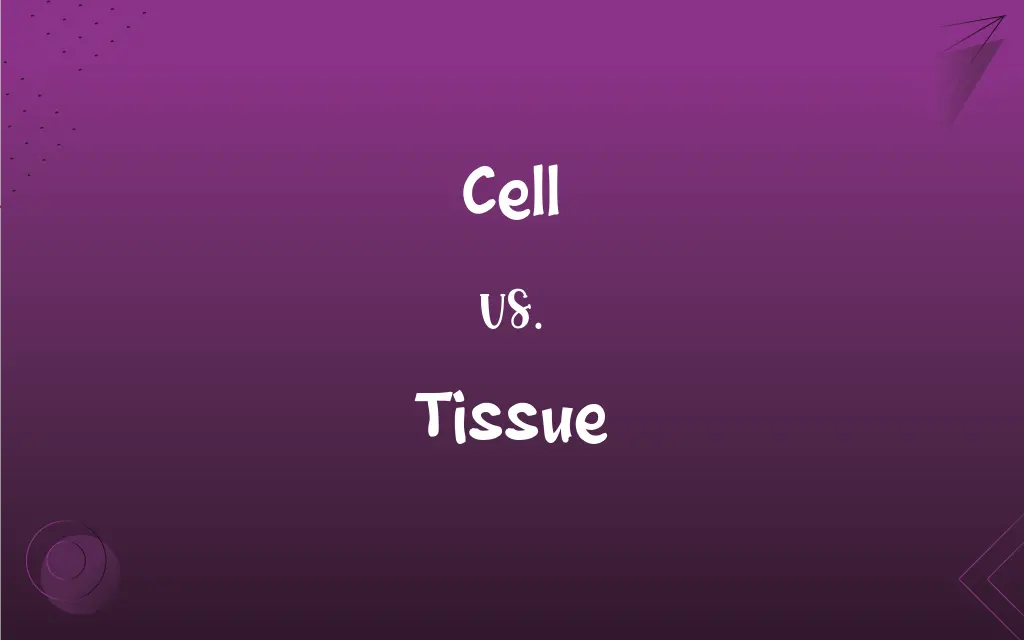Cell vs. Tissue: What's the Difference?
Edited by Aimie Carlson || By Harlon Moss || Updated on October 27, 2023
A cell is the basic unit of life, while tissues are groups of similar cells performing a specific function.

Key Differences
A cell is often described as the building block of life. Every living organism, from the simplest bacteria to complex multicellular organisms like humans, is made up of cells. These microscopic entities contain the essential machinery needed for life, including genetic material, cytoplasm, and cell-specific organelles. In contrast, tissue refers to a collection of similar cells and their intercellular substances, which together execute a particular function in the body.
While a cell acts as an individual unit with its specialized functions, tissue represents a higher level of organization in living organisms. For instance, muscle cells individually can contract and produce force, but when grouped together as muscle tissue, they can perform coordinated movements, such as lifting an object or pumping blood through the heart.
The diversity of cell types in an organism is astounding, with each type uniquely tailored to its function. For example, red blood cells transport oxygen, while nerve cells transmit electrical signals. However, when we talk about tissue, we refer to how these cells operate as cohesive units. Nerve cells collectively form neural tissue, enabling the intricate network of communication throughout the body.
It's also worth noting the relationship between cell and tissue concerning growth and repair. Cells divide and proliferate, ensuring the growth and maintenance of an organism. When certain cells of a specific type come together and multiply, they give rise to tissues. As an illustration, skin cells continually divide to replenish the skin tissue, ensuring it remains a protective barrier for the body.
Comparison Chart
Definition
Basic unit of life
Group of similar cells performing a specific function
ADVERTISEMENT
Complexity
Single unit
Composed of many cells
Function
Has individual functions based on cell type
Performs coordinated functions due to the collective cell action
Example
Red blood cell, nerve cell
Muscle tissue, epithelial tissue
Level of Organization
Smallest functional unit of life
Intermediate level between cells and organs
Cell and Tissue Definitions
Cell
An individual compartment in organisms that can function independently.
Each cell in the body has a specific role, like skin cells protecting us from external harm.
ADVERTISEMENT
Tissue
A collection of cells that work together to perform a specific function.
Muscle tissue contracts to facilitate movement in the body.
Cell
A microscopic structure containing the necessary machinery for growth, reproduction, and function.
Under the microscope, you can observe various organelles within a cell.
Tissue
An organized structure formed by similar cells and their intercellular materials.
Epithelial tissue covers the body's external and internal surfaces.
Cell
The fundamental unit of life in all living organisms.
Every human body contains trillions of cells, each playing a crucial role.
Tissue
A group of cells in multicellular organisms serving a common purpose.
Nervous tissue helps in transmitting electrical signals across the body.
Cell
A singular biological entity enclosed by a membrane.
The cell nucleus holds the genetic material directing the cell's activities.
Tissue
The combination of cells and extracellular matrix, collaborating for a common task.
Connective tissue provides support and binds other tissues together.
Cell
The smallest living unit capable of independent existence.
A single bacterial organism is composed of just one cell.
Tissue
Cells and fibers grouped together in animals or plants.
Plant tissues, like xylem, help transport water from roots to leaves.
Cell
A narrow confining room, as in a prison or convent.
Tissue
A fine, very thin fabric, such as gauze.
FAQs
Are all cells within a tissue identical?
While cells within a tissue are similar and serve a common function, they may have slight variations.
Can an organism be single-celled?
Yes, organisms like bacteria are single-celled and perform all life processes within that one cell.
What is the primary role of a cell?
A cell is the basic unit of life, responsible for individual functions based on its type.
How many types of cells are in the human body?
The human body has over 200 different types of cells, each tailored for specific functions.
Can a cell survive outside of tissue?
Some cells, like bacteria, thrive independently, but many multicellular organism cells rely on tissue structures for survival and function.
What gives tissues their unique characteristics?
The specific cell type and the extracellular matrix in a tissue give it unique characteristics.
How do tissues relate to cells?
Tissues are groups of similar cells that come together to perform a specific function.
What is an example of a tissue in plants?
An example of plant tissue is the phloem, responsible for transporting sugars.
How do cells maintain tissue function?
Cells continuously regenerate, replace damaged cells, and ensure the ongoing health and function of tissues.
How do cells in a tissue communicate?
Cells in a tissue communicate through chemical signals, direct cell-to-cell contact, and other mechanisms.
Can tissues regenerate?
Yes, some tissues like skin and liver can regenerate, while others, like nervous tissue, have limited regenerative capabilities.
Are there tissues in all living organisms?
While all organisms have cells, not all have tissues. Tissues are found in multicellular organisms.
Is blood considered a tissue?
Yes, blood is a connective tissue comprising different cell types and plasma.
What provides structural support in tissues?
The extracellular matrix, composed of fibers and ground substance, provides structural support in tissues.
How are cells held together in a tissue?
Cells in tissues are held together by cell junctions, adhesive molecules, and the extracellular matrix.
What is the role of stem cells concerning tissues?
Stem cells can differentiate into various cell types, aiding in tissue growth, repair, and regeneration.
What is the study of tissues called?
The study of tissues is known as histology.
Why are cell and tissue studies vital in medicine?
Studying cells and tissues helps understand diseases at a cellular level, leading to better diagnosis, treatments, and preventive measures.
What's the connection between tissues and organs?
Organs are structures made up of multiple types of tissues working in harmony for a specific, larger function.
Can cells change their function within a tissue?
Generally, cells have a specific function, but some cells, under certain conditions, can change or adapt their function.
About Author
Written by
Harlon MossHarlon is a seasoned quality moderator and accomplished content writer for Difference Wiki. An alumnus of the prestigious University of California, he earned his degree in Computer Science. Leveraging his academic background, Harlon brings a meticulous and informed perspective to his work, ensuring content accuracy and excellence.
Edited by
Aimie CarlsonAimie Carlson, holding a master's degree in English literature, is a fervent English language enthusiast. She lends her writing talents to Difference Wiki, a prominent website that specializes in comparisons, offering readers insightful analyses that both captivate and inform.































































